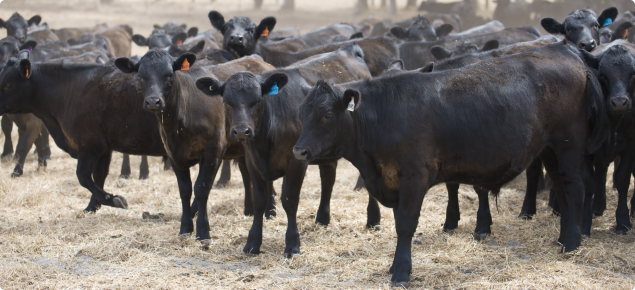An animal's nutritional requirement will vary according to their growth stage and physiological state. Feed budgets will be different for yearling cattle, heifers or adult, late pregnant cows, cows with calves and bulls.
Monitoring stock condition
Monitoring cattle condition is critical for calculating the correct amount of supplementary feeding and the formulation of rations. Energy requirements for breeders are highest during the latter stages of pregnancy and in early lactation. Fat reserves are critical for growth, reproduction, and lactation.
Cattle, particularly pregnant stock, should be maintained at condition score 3 (out of a 5 point scoring system) to avoid any complications at calving.
It is advised to condition score stock, and manage accordingly.
Feeding
Key messages
- Feed supplies, particularly hay, grain and pellets are in short supply, with the wait for pellets exceeding four weeks at some distributors. It is critical to feed budget and organise a supply of supplementary feeding.
- A feed analysis is the only accurate way to determine the value of the feed being offered to your cattle.
- Key figures to know are energy, protein, fibre, and dry matter of the feed. With this information, feed budgets can be made simply utilising online feed budget tools.
- Compare the feed costs based on the component you are buying the feed for – energy, protein, or fibre. Plan for feed costs to rise as availability declines.
- Segregate cows according to calving time and differentially feed.
Maximum daily dry matter intake will limit the amount of roughage an animal can consume. A balanced ration will need to include pellets to ensure energy demands are met.
To avoid any mineral deficiencies and related disease, ensure minerals are supplied through lick blocks or provided in feed.
Feeding grains such as oats or barley may be an alternative option if hay supply is limited. Managing the transition is important and the introduction of any new feed option needs to be gradual. A sudden introduction of feed will disrupt the microbes in the rumen, and may result in grain overload, acidosis or grain poisoning. Ensure a good quality source of hay or silage is always available and that it makes up at least 20% of the ration (unless feeding a complete ration where the roughage and grain are mixed).
Introduce oats/barley to cattle by starting with 500g per head per day, followed by increases of 500g per head every fourth day until the required ration is reached. To transition to wheat or barley from oats, increase the wheat or barley portion by 25% of the oat ration every five days over 16 days. For example, if the current oat ration is 500g, start by adding 125g of wheat or barley to every 375g of oats. Lupin seed is another option but should be cracked to increase digestibility when fed to cattle.
Below are some examples of the quantities required to provide a full ration to different classes of cattle. Consider how much feed is required per day for your herd, and the length of time feeding may be required. Scenario plan for different breaks to the season and source extra feed early where you determine there is a shortfall between feed stocks on hand and cattle requirements.
Table from Vic DPI – Drought feeding and management of beef cattle – A guide for farmers and land managers
Water requirements
Key messages
- Budget your water early, this may become your most limited resource. Based on experience, consider how much water is available, how much water stock will require and keep evaporation in mind.
- Have a water plan that considers the worst-case scenarios.
- Small dams are inefficient water stores, especially with high rates of evaporation. Water quality may decline quickly with high levels of salt and animal manure.
- Continue monitoring water quantity and quality.
| Cattle type | Maximum demand (L/day) |
|---|---|
| Weaners (250-300kg) | Up to 70 |
| Cattle (adult, dry) | Up to 100 |
| Cattle (lactating) | Up to 160 |
| Dairy cattle (dry) | Up to 112 |
| Dairy cattle (lactating) | Up to 210 |
Welfare considerations
Stock owners and managers have an obligation to ensure animal welfare including sufficient food, water and shelter is provided. Where sufficient food and/or water requirements cannot be met, management decisions should be made early. Cattle should be moved to where feed and water is sufficient, or they should be sold or humanely destroyed.
Under animal welfare law in Western Australia, a person must ensure an animal suffering from severe distress, disease or injury that cannot be reasonably treated, is humanely destroyed promptly and safely by a competent person, or under the direct supervision of a competent person.
For further information on the humane destruction of sheep and cattle.
Funding and support services
Information on support services to assist people in regional WA cope with stressful situations can be found on the WA's rural support services webpage and directory, including Regional Men’s Health Initiative, Rural Aid and the Rural West financial counselling service.
For resources and information on grants and funding available to assist growers, pastoralists and industry experiencing hardship in challenging times, please refer to the Funding and support information for WA primary producers document.
Contact
Danny Roberts
DPIRD Veterinary officer
e danny.roberts@dpird.wa.gov.au
p 08 9892 8535

